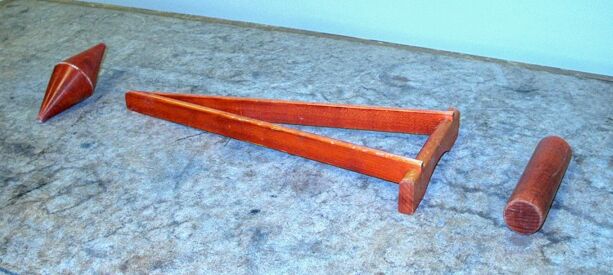
A video of this demonstration is available at this link.
On this V-shaped ramp, the cylinder rolls downhill, to the left, but the double cone rolls uphill, to the right.

A video of this demonstration is available at this link.
On this V-shaped ramp, the cylinder rolls downhill, to the left, but the double cone rolls uphill, to the right.
The center of mass of an object is the weighted mean displacement of all of its mass points from some reference point, usually the origin of the coordinate system in which the object sits. This is the sum of the products of all the mass points with their distances from the origin, divided by the total mass of the object (rcm = Σmiri/M). It is usually most convenient to set the center of mass of the object at the origin, but whatever our reference point, for both the cylinder and the double cone in this demonstration, the center of mass lies on the central axis, equidistant from both ends.
If the object is relatively small, and close to the earth, then gravity acts uniformly on the object. That is, if the object is of uniform density, gravity exerts the same downward force on all of its mass points, and the sum of all of these forces is equal to a single downward force, F = Mg, acting at the center of mass of the object. This point is thus also called the center of gravity.
When an object is situated so that, when gravity acts on it, by moving in a particular direction it can lower its center of mass and thus lower its gravitational potential energy, then the object moves in that direction. A familiar example is a ball rolling down a hill.
The V-shaped ramp is made so that its vertex lies lower than its wide end, so that the downhill direction is from the wide end to the vertex. As noted above, for both the cylinder and the double cone, the center of mass lies on the central axis, equidistant from both ends. If you place the cylinder at the wide end of the ramp, it rolls down the ramp, as we should expect. Since the cylinder has the same radius over its entire length, as it rolls on the ramp, its center of mass stays the same level above the ramp. Thus, as it rolls down the ramp from the high end to the low end, it lowers its center of mass, and thus also its gravitational potential energy.
If, however, you place the double cone at the wide end of the ramp, it merely sits there. At this end of the ramp, the double cone rests on the rails of the ramp near its ends, where its radius is smallest. If you roll the double cone down the ramp towards its vertex, as the rails get closer together, they support the double cone closer and closer to its center, where its radius is largest, so that the radius of the cone where the rails support it increases as it rolls down the ramp. The cone angle and the angle between the rails are such that the rate of this increase in radius exceeds the slope of the ramp. Rolling the double cone in this direction thus raises its center of mass and its gravitational potential energy. This means that if you place the double cone at the low end of the ramp, where it rests on the rails near its center, its center of mass and its gravitational potential energy are higher than they are when the cone is at the high end of the ramp. The double cone thus rolls along the ramp in the uphill direction, because as it does so, the height of its center of mass decreases, and so does its gravitational potential energy.